The word ‘replica’ isn’t something that would normally fill me with excitement, all too often implying fake or second best. But when you’re talking prehistoric paintings, ‘replica’ suddenly becomes an acceptable word and never more so than at Lascaux in the French department of Dordogne.
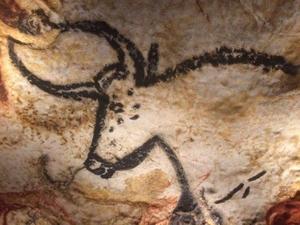 Discovered in 1940 by four teenagers, the Lascaux caves are world famous for their polychrome animal paintings, the size of the figures, and the sheer concentration of images. Opened to the public in 1948, the cave was closed permanently in 1963 to stop increased humidity further damaging the images. So the idea of a full-scale replica is really something to get excited about.
Discovered in 1940 by four teenagers, the Lascaux caves are world famous for their polychrome animal paintings, the size of the figures, and the sheer concentration of images. Opened to the public in 1948, the cave was closed permanently in 1963 to stop increased humidity further damaging the images. So the idea of a full-scale replica is really something to get excited about.
The new attraction is built at the base of Lascaux hill on the edge of Montignac, a small town in the valley of the Vezere, which feeds into the Dordogne. Officially called the International Cave Painting Centre, it is popularly known as Lascaux IV. In 1983, a replica of two principal sections of the paintings was opened inside the hill close to the original cave – Lascaux II – which remains open for themed visits. And in 2012, mobile replicas began an ongoing world tour as Lascaux III, which this year will be touring Japan.
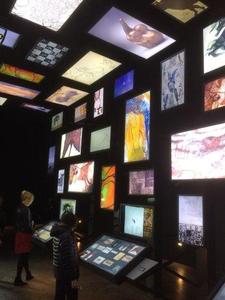 I was lucky to be part of a small group of UK journalists invited to a private preview of Lascaux 4 in November, just days before the official opening by outgoing French President, François Hollande. Workmen were still adding finishing touches inside and out, whilst the sales team were busy stocking the shop with fridge magnets, books and cuddly sabre-toothed lions. The sense of excitement was palpable.
I was lucky to be part of a small group of UK journalists invited to a private preview of Lascaux 4 in November, just days before the official opening by outgoing French President, François Hollande. Workmen were still adding finishing touches inside and out, whilst the sales team were busy stocking the shop with fridge magnets, books and cuddly sabre-toothed lions. The sense of excitement was palpable.
The visit is split into the replica cave and the exhibition areas, and visitors will be encouraged to book online as tours of the cave are timed and guided by knowledgeable facilitators. The rest of the displays you do at your own pace with the help of a high-tech but simple-to-use electronic pad. Touch it against the activation points for background information and animations which are relayed through open headsets. These enable you – but not your companions – to hear the commentary, yet you can still talk to your friends or the many human sources of information.
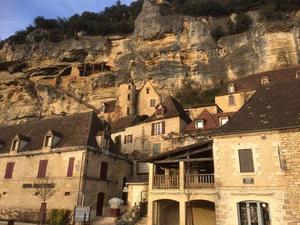 The visit starts on the roof of the long, low building which mirrors the contours of Lascaux hill, but the whole site is full accessible with a lift to the roof and gently sloping paths leading down ‘in the footsteps of the teenagers’ to the cave entrance. And once inside, I defy anyone to feel they are inside a fake. I’ve visited several caves in France with original paintings and this is as good as it gets. Every last contour and imperfection in the rock is faithfully produced, the bulls and bison, the horses, ibex and stags so realistic they seem to bound across the walls and ceiling.
The visit starts on the roof of the long, low building which mirrors the contours of Lascaux hill, but the whole site is full accessible with a lift to the roof and gently sloping paths leading down ‘in the footsteps of the teenagers’ to the cave entrance. And once inside, I defy anyone to feel they are inside a fake. I’ve visited several caves in France with original paintings and this is as good as it gets. Every last contour and imperfection in the rock is faithfully produced, the bulls and bison, the horses, ibex and stags so realistic they seem to bound across the walls and ceiling.
Inside the cave, your facilitator – they prefer that to ‘guide’ – urges you to look, to ponder, and to ask questions about what the paintings mean and what sort of artists produced them. Many questions will never be answered but it’s fascinating to speculate why the muzzle of a bear shows above the stomach of a bull, its paw beneath the belly; why there’s just one depiction of a man, but with the head of a bird; and whether the four stags with heads held high are really swimming through a river.
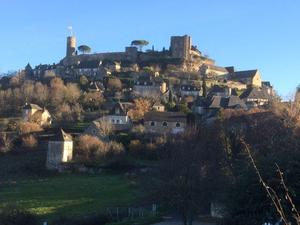 At the end of the visit, the Workshop area gives you a chance to look more closely at specific sections of the paintings, including those inaccessible in the original cave, and therefore also in the replica. There’s an excellent 3-D film that puts Lascaux in the context of prehistoric art across the world; a digital art gallery where you can have fun putting your own exhibition together; and the chance to discover the changing views on prehistoric art through three multi-media ‘theatre’ tableaux.
At the end of the visit, the Workshop area gives you a chance to look more closely at specific sections of the paintings, including those inaccessible in the original cave, and therefore also in the replica. There’s an excellent 3-D film that puts Lascaux in the context of prehistoric art across the world; a digital art gallery where you can have fun putting your own exhibition together; and the chance to discover the changing views on prehistoric art through three multi-media ‘theatre’ tableaux.
There’s also – somewhat unusually for French heritage attractions – a small cafe serving a simple menu of locally sourced food with views over pools and lawns (still mud during my visit!). Time required? I’d say a minimum of three hours, depending on your level of interest. Tickets cost €16 for Adults; €15 for Seniors – full details from www.lascaux.fr/en.
The International Cave Centre is likely to be a highlight for the many British visitors who flock to the Dordogne department every summer. The county town of Perigueux – west of Montignac and Lascaux – is well worth a visit with its unusual domed cathedral of Saint-Front and medieval streets. But this whole area is packed with goodies, all within an hour’s drive of Montignac.
I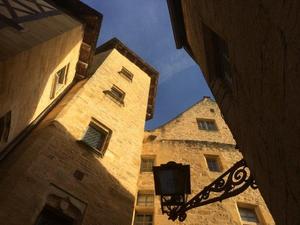 first came here as a teenager and have been a regular visitor ever since, drawn back by its historic towns and villages, river scenery, and strong foodie culture. Amongst the Dordogne’s other gems are Sarlat, a showpiece market town rich in fine buildings and oozing history from every mellow stone. Take the lift up the tower of the deconsecrated church for panoramic rooftop views, then browse the food stalls inside the old nave for caramelised walnuts, foie gras, and local Bergerac wines. A few miles to the south, La Roque-Gageac is rightly classified as one of France’s Most Beautiful Villages with its river frontage, winding streets and tropical micro-climate plants.
first came here as a teenager and have been a regular visitor ever since, drawn back by its historic towns and villages, river scenery, and strong foodie culture. Amongst the Dordogne’s other gems are Sarlat, a showpiece market town rich in fine buildings and oozing history from every mellow stone. Take the lift up the tower of the deconsecrated church for panoramic rooftop views, then browse the food stalls inside the old nave for caramelised walnuts, foie gras, and local Bergerac wines. A few miles to the south, La Roque-Gageac is rightly classified as one of France’s Most Beautiful Villages with its river frontage, winding streets and tropical micro-climate plants.
To many overseas visitors, the Dordogne department is synonymous with the Dordogne Valley, but in fact the river passes through many departments, the neighbouring ones to the east being Correze and Lot. On my winter visit, I stopped off at another of those elite villages, Turenne in Correze, to wind up the quaint cobbled streets without summer crowds. I wandered through the market place in medieval Martel, alone except for the all-pervading sound of band practice, and I wound down on foot past the Stations of the Cross at the sheer pilgrims’ village of Rocamadour in Lot.
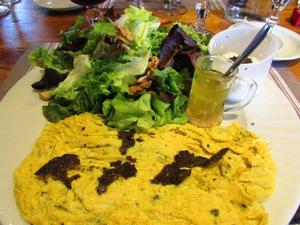 There were foodie treats on the itinerary too. A welcome return to the Denoix distillery in Brive-la-Gaillarde for a tasting of walnut liqueur and a fun afternoon making chocolates at the nearby Chocolaterie Lamy. I stopped off at La Borie d’Imbert, a goat cheese farm at Rocamadour where visitors can meet the ever-friendly goats and buy farm-fresh produce, and – a real winter treat – spent a morning hunting black truffles with super-sniff Labrador Rosabelle at La Ferme de la Truffe in Cuzance. Back at the farm restaurant, we sampled a huge golden omelette dotted with ‘black diamonds’, accompanied by a green salad dressed with fresh walnut oil, and followed by local cheese. Surely even Cro-Magnon man can’t have had it this good!
There were foodie treats on the itinerary too. A welcome return to the Denoix distillery in Brive-la-Gaillarde for a tasting of walnut liqueur and a fun afternoon making chocolates at the nearby Chocolaterie Lamy. I stopped off at La Borie d’Imbert, a goat cheese farm at Rocamadour where visitors can meet the ever-friendly goats and buy farm-fresh produce, and – a real winter treat – spent a morning hunting black truffles with super-sniff Labrador Rosabelle at La Ferme de la Truffe in Cuzance. Back at the farm restaurant, we sampled a huge golden omelette dotted with ‘black diamonds’, accompanied by a green salad dressed with fresh walnut oil, and followed by local cheese. Surely even Cro-Magnon man can’t have had it this good!
Tourist information from:
www.visit-dordogne-valley.co.uk
For accommodation in Montignac, try www.laroseraie-hotel.com











